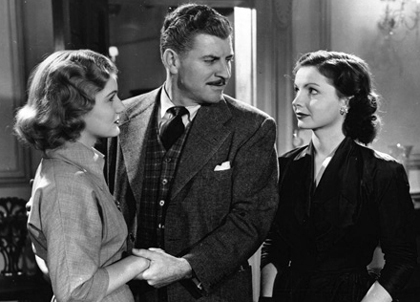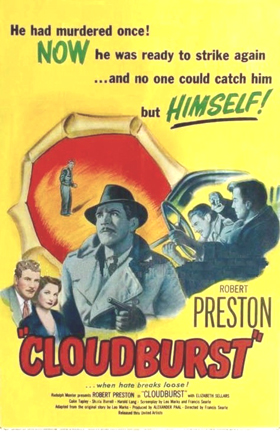
 |
|
|
|
Hammer expert Ted Newsom tipped me off that the MGM Limited Edition Collection disc of Cloudburst, a title completely unknown to me, was in actuality a very scarce early Hammer Film, made years before that company's Science Fiction and Horror breakthroughs. Released in England under the label Exclusive Films, Hammer films were exported by United Artists, or sometimes, independent producer Robert Lippert. In many cases these second-rank British pictures recruited American actors looking for extra work or having career difficulties. Cloudburst stars the very American Robert Preston and features the lovely Elizabeth Sellars (The Barefoot Contessa, 55 Days at Peking) as his love interest. These Hammer/Exclusive pictures were all over the place for quality. The first exposure for us Hammer-philes came when we tracked down the early films of Terence Fisher, some of which are lumpy thrillers no more distinguished than his awkward early Sci-Fi efforts Four Sided Triangle and Spaceways. Cloudburst is not only a good movie, it resonates with themes of vengeance and 'moral killing' that would later dominate genre and action filmmaking. Its hero is much like the obsessed, anti-social characters in later Hammer horror films. The script is a singularly autobiographical work by the intriguing and legendary Leo Marks. Finally, the movie makes a connection between the ruthlessness and cruelty of WW2 with and rising brutality of postwar life, that reminds us of author David J. Skal's linkage between the horrors of WW1 and the rise of the first horror wave back in the 1930s. The story seems a psychological extension of the remorseless moral mindset of WW2 intelligence operations. The fighting is barely over, but dedicated cryptographer John Graham (Robert Preston) still runs his group of code breakers on a wartime basis. His only peace of mind comes via his loving wife Carol, a former colleague in espionage (Elizabeth Sellars), who insists that he needs rest. Carol's severe limp is a reminder of her torture at the hands of the Gestapo. But she never talked, and thus saved John's life. When Carol is brutally run down by a pair of escaping criminals, John devotes his entire being to cold vengeance. He gives false information to the police and traces the fugitives on his own. To this end he employs old friends from the spy trade, now working in civilian jobs. Along the way he slips up, giving Scotland Yard Inspector Davis (Colin Tapley) enough of a clue to draw suspicion on himself. But John refuses to abandon his dark quest, which he treats as a suicide mission -- he keeps a cyanide pill taped to the underside of his lapel. Meanwhile, John's dedicated code breaking staff works day and night to crack the clue that will unmask him as the avenging killer. 
Cloudburst hits us right off the top with Frank Spencer's rich, serious-sounding main title theme, preparing us for something other than a frivolous thriller. The first thing we realize is that this is an almost autobiographical piece by Leo Marks, one of Britain's most accomplished code breakers and spymasters. Beginning as an unworldly mathematician, by the end of the war Marks was personally dispatching brave secret agents to France and Holland, to work with the underground resistance. A man who believed in logic and rationality, Marks devised a throwaway one-use-only code written on disposable silk that didn't need to be memorized. But the job entailed sending dozens of patriots to their deaths, including the famous Violette Szabo. 1 We get the idea from Marks' book Between Silk and Cyanide: A Codebreaker's War that he was a 'wounded' personality, very much like John Graham of Cloudburst. Leo Marks experienced far more than his share of anguish and guilt, never knowing if the horrible tortures endured by his captured agents were unavoidable, or if his own hubris and arrogance caused him to give them fatal instructions. From within Marks' overly clever writing style we detect a man who's "not quite right with himself". John Graham's murderous crusade is at first a little disappointing, especially because the movie has established such a positive feeling toward Carol, and now seems intent on a ten-cent vengeance plot. But John is such a rational expert at the dirty tricks of espionage -- fighting skills, subterfuge with license plates -- and uniquely positioned to get expert help, that we root for him as he tracks down his targets. Frankly, he's a little like the obsessed intellectual heroes that would dominate the first wave of Hammer successes, Brian Donlevy's Bernard Quatermass and Peter Cushing's Baron Frankenstein. All three men have extravagantly specialized knowledge and bizarre career objectives that separate them from "normal" citizens. Robert Preston at first seems to be doing Ronald Colman, but he most resembles a more romantic version of perennial Hammer stalwart André Morell. Even more apt is the connection between John Graham and a much more prominent Leo Marks creation, Mark Lewis of the notorious horror film Peeping Tom. Like the camera fanatic Lewis, John has a secret room with a screen that projects not horrible snuff films, but the raw material of codes to be broken. These codes are even projected on John's back as he crosses the room. This raises the question, are Mark Lewis's snuff films psychological puzzles that he is trying to decode? Both "maniacs" carry out their unspeakable secret missions under the noses of Scotland Yard detectives. John Graham does not attain Mark Lewis's level of homicidal mania, but his killings are almost as disturbing -- and illustrated with very Peeping Tom- like POV shots rushing into the victim's surprised faces. The instant cuts to black are disturbing in a decidedly Leo Marks-Michael Powell fashion. Finally, both men are morbidly aware that their capture is imminent, and both have prepared suicides using paraphernalia from their respective vocations. Cloudburst is a disturbing thriller when seen unprepared, because its focus on a brutally murderous, anti-social killer hero, so common today, was unheard-of in 1951. Hammer Horror fans capable of appreciating the Peeping Tom connection should realize that they've made a very interesting discovery! 
Cloudburst obviously provides fresh meat for Hammer fans to chew, especially because it (in my opinion) is more rewarding than quite a few of the early Bray Studios productions that have surfaced in the past few years. Not a lot in director and co-screenwriter Francis Searle's filmography seems familiar, but he's done a fine job with this show on all counts. There are a couple of good fights and the violent action has an unsavory edge not associated with 'polite' English filmmaking of the time. "Bad" woman Lorna Dawson (Sheila Burrell of Hammer's Paranoiac) practically makes the camera wilt with her baleful stare. Director Searle handles some of the film's loose ends quite well, allowing Carol's sister Peggy (Mary Germaine) a moment of sadness when she discovers that she's not likely to replace Carol in John's affections. We jump when we recognize actor Harold Lang, who would later portray a meddling detective in Val Guest's The Quatermass Xperiment. The same goes for George Woodbridge and Thomas Heathcote, familiar personalities from later Hammer attractions. The credits carry Hammer's makeup man Philip Leakey (who handles a couple of very realistic scars) and later Hammer scribe Jimmy Sangster is the assistant director. It's as if someone invented an unknown, quality Hammer film out of whole cloth, just for us to enjoy. The script for Cloudburst has only a couple of clunker lines, one of them being the heroine's explanation of the title, which still doesn't fit the movie very well. But one incredible zinger has Colin Tapley's detective exclaiming about the theoretical killer he's yet to identify or pin down: "We have to get into his mind!" This one line leapfrogs us forward to all the post- The Silence of the Lambs serial killer pictures in which cops must grok the mental mindset of their prey. The low-rent criminals in Cloudburst are unimportant, but it seems shocking that the "mad killer" is such a respected member of the intelligence network -- author Leo Marks is identifying himself as a man who could be motivated to commit extraordinary anti-social actions, like extra-legal killings. I think that Cloudburst promotes the notion that the ruthlessness, torture and atrocities of the war have altered the moral landscape: a decent, patriotic and moral man like John Graham now has so little to believe in and so few moral inhibitions that he'll undertake a "secret mission" of murderous vengeance. Like the TV show 24, Graham tortures his prey to get the information he wants, and exults in killing a man and a woman in cold blood, by gruesome means. He's certainly gone part of the way down the road to the moral indifference of Dr. Frankenstein, or the obsessive mania of Mark Lewis. The changing attitude toward "taboo" horror film content -- gore, cruelty, sex corruption -- was the big contribution of the New Wave of horror in the late 1950s, begun by Britain's Hammer Films. Cloudburst makes an explicit connection between that fantasy movie trend, and the new "moral murderers" of extreme warfare. The MGM Limited Edition Collection DVD of the delightful early Hammer rediscovery Cloudburst is a very good encoding of this 1951 B&W film. The disc's standard quality disclaimer is unnecessary, for the occasional light scratches do not pose much of a problem. The image is sharp and distinct, and very steady, and a wide grayscale is rendered. The audio track is also in fine shape -- no muffled voices or distortion to speak of. Music precedes the fade up on the title and hangs over the end of the final fade, leading one to surmise that United Artists removed opening and closing title cards mentioning Hammer Films. I've seen this happen on some later pictures, like The Quatermass Xperiment. More tantalizing is the realization that the original British cut of Cloudburst is a full nine minutes longer. What's missing? Some scenes end in fades that have a "superimposed" quality. Quick, when's the next flight to London? I'm certain that the film industries of both nations will drop everything to restore this important film! 2 The disc comes with an original trailer, which is unfortunately textless. Text lettering was meant to cover much of the trailer with stars' names and title treatment artwork. If you haven't gotten my drift yet, let me again state that Cloudburst is an enormous surprise, and a rich discovery for lovers of Hammer Films, Leo Marks & Peeping Tom, and fans of horror film history. I hope I haven't oversold it to more conventional film fans. Hey, it's Robert Preston before The Music Man. Instead of selling band instruments, he's a borderline psycho on a murder mission!
On a scale of Excellent, Good, Fair, and Poor,
Cloudburst rates:
Footnote:
1. Violette Szabo's story makes for inspiring, heartbreaking viewing; the shattering poem associated with her was written by Leo Marks.
2. 5.23.2011: Oops! After getting all excited about the prospects for a longer cut of Cloudburst, faithful correspondent Stefan Anderson led me to the BBFC's page on the movie which clearly states that the movie was released at the same length in England as well. The site mentions that the film was cut, but if a longer version exists in some English vault, it would have to have somehow survived for... only 60 years. Fudge. I guess the next thing to do would be to find an original Leo Marks as-filmed script.
Reviews on the Savant main site have additional credits information and are often updated and annotated with reader input and graphics. Also, don't forget the 2010 Savant Wish List. T'was Ever Thus.
Review Staff | About DVD Talk | Newsletter Subscribe | Join DVD Talk Forum |
| ||||||||||||||||||